Computer Maintenance and Technical Support: Power Supply Report
VerifiedAdded on 2021/08/16
|12
|3156
|287
Report
AI Summary
This report, prepared by a group of IT students at Hawassa University, provides a comprehensive overview of power supplies. It begins with the fundamental concepts of power supplies, explaining their function and essential components like transformers, rectifiers, and filters. The report then delves into various types of power supplies, including SMPS, UPS, AC, DC, regulated, and programmable power supplies, detailing their advantages, applications, and block diagrams. It also covers computer power supplies (AT, ATX, BTX) and linear power supplies. Furthermore, the report explores different types of batteries, such as primary and secondary batteries (SMF, Li, NiDd, Lead Acid), and discusses common power supply problems like voltage instability and waveform distortion, along with potential solutions like power factor correction and voltage optimization. References are included to support the information presented.
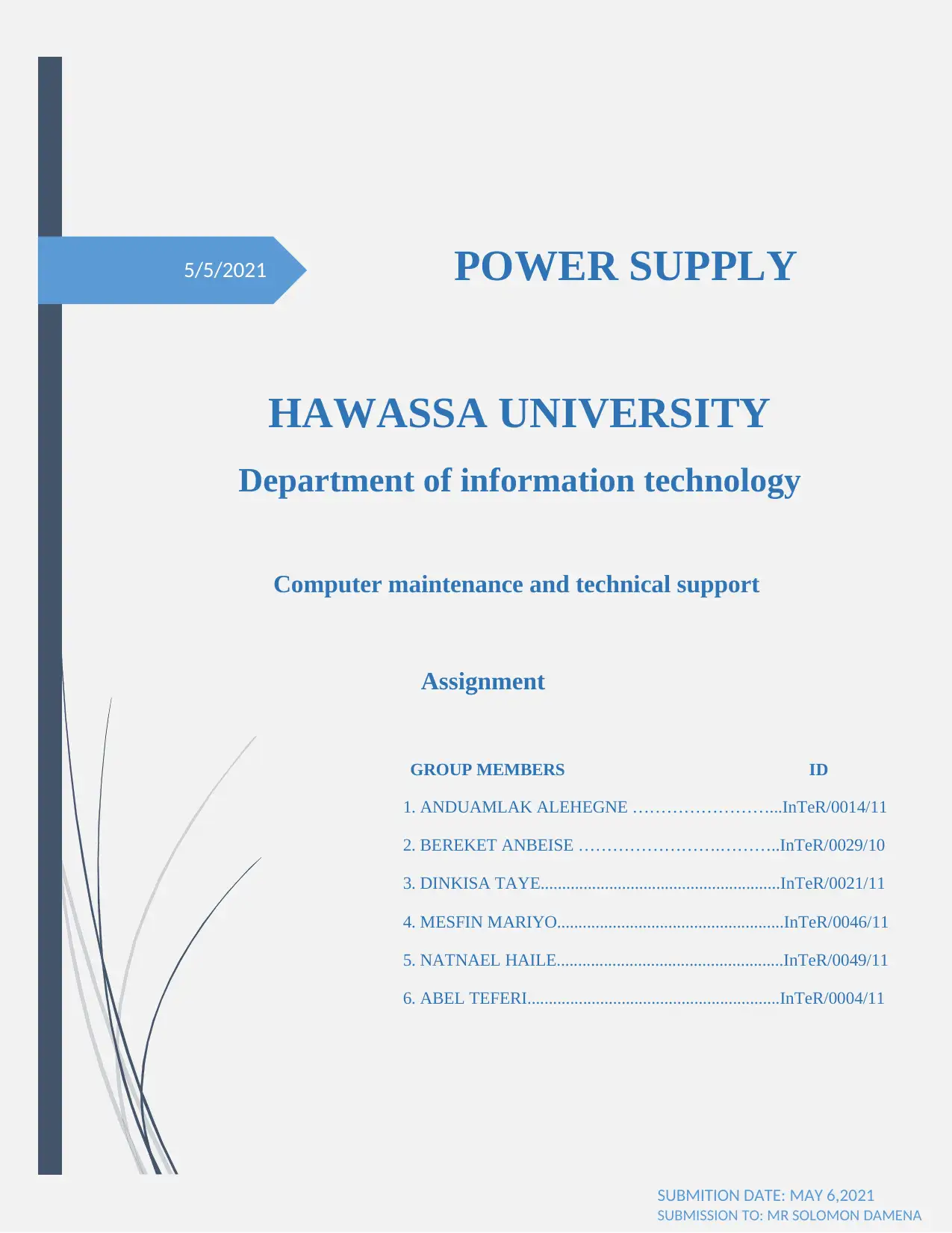
5/5/2021 POWER SUPPLY
SUBMITION DATE: MAY 6,2021
SUBMISSION TO: MR SOLOMON DAMENA
GROUP MEMBERS ID
1. ANDUAMLAK ALEHEGNE ……………………...InTeR/0014/11
2. BEREKET ANBEISE …………………….………..InTeR/0029/10
3. DINKISA TAYE........................................................InTeR/0021/11
4. MESFIN MARIYO.....................................................InTeR/0046/11
5. NATNAEL HAILE.....................................................InTeR/0049/11
6. ABEL TEFERI...........................................................InTeR/0004/11
HAWASSA UNIVERSITY
Department of information technology
Computer maintenance and technical support
Assignment
SUBMITION DATE: MAY 6,2021
SUBMISSION TO: MR SOLOMON DAMENA
GROUP MEMBERS ID
1. ANDUAMLAK ALEHEGNE ……………………...InTeR/0014/11
2. BEREKET ANBEISE …………………….………..InTeR/0029/10
3. DINKISA TAYE........................................................InTeR/0021/11
4. MESFIN MARIYO.....................................................InTeR/0046/11
5. NATNAEL HAILE.....................................................InTeR/0049/11
6. ABEL TEFERI...........................................................InTeR/0004/11
HAWASSA UNIVERSITY
Department of information technology
Computer maintenance and technical support
Assignment
Paraphrase This Document
Need a fresh take? Get an instant paraphrase of this document with our AI Paraphraser

Table of Contents
Power Supply ................................................................................................................................................ 2
Parts inside a power supply are: ................................................................................................................ 2
Power Supply Block Diagram .................................................................................................................. 3
Types of power supply ................................................................................................................................ 3
SMPS- Switched Mode Power Supply ..................................................................................................... 3
Uninterruptible Power Supply .................................................................................................................. 4
AC Power Supply ..................................................................................................................................... 4
DC Power Supply ..................................................................................................................................... 5
Regulated Power Supply ........................................................................................................................... 5
Programmable Power Supply.................................................................................................................... 6
Computer Power Supply ........................................................................................................................... 6
Linear Power Supply ................................................................................................................................. 7
Batteries ....................................................................................................................................................... 7
Types of Batteries .................................................................................................................................... 8
1) Primary Batteries: ................................................................................................................................. 8
2) Secondary Batteries: ............................................................................................................................. 8
Common problems and solution of power supply .................................................................................... 9
References .................................................................................................................................................. 10
Power Supply ................................................................................................................................................ 2
Parts inside a power supply are: ................................................................................................................ 2
Power Supply Block Diagram .................................................................................................................. 3
Types of power supply ................................................................................................................................ 3
SMPS- Switched Mode Power Supply ..................................................................................................... 3
Uninterruptible Power Supply .................................................................................................................. 4
AC Power Supply ..................................................................................................................................... 4
DC Power Supply ..................................................................................................................................... 5
Regulated Power Supply ........................................................................................................................... 5
Programmable Power Supply.................................................................................................................... 6
Computer Power Supply ........................................................................................................................... 6
Linear Power Supply ................................................................................................................................. 7
Batteries ....................................................................................................................................................... 7
Types of Batteries .................................................................................................................................... 8
1) Primary Batteries: ................................................................................................................................. 8
2) Secondary Batteries: ............................................................................................................................. 8
Common problems and solution of power supply .................................................................................... 9
References .................................................................................................................................................. 10
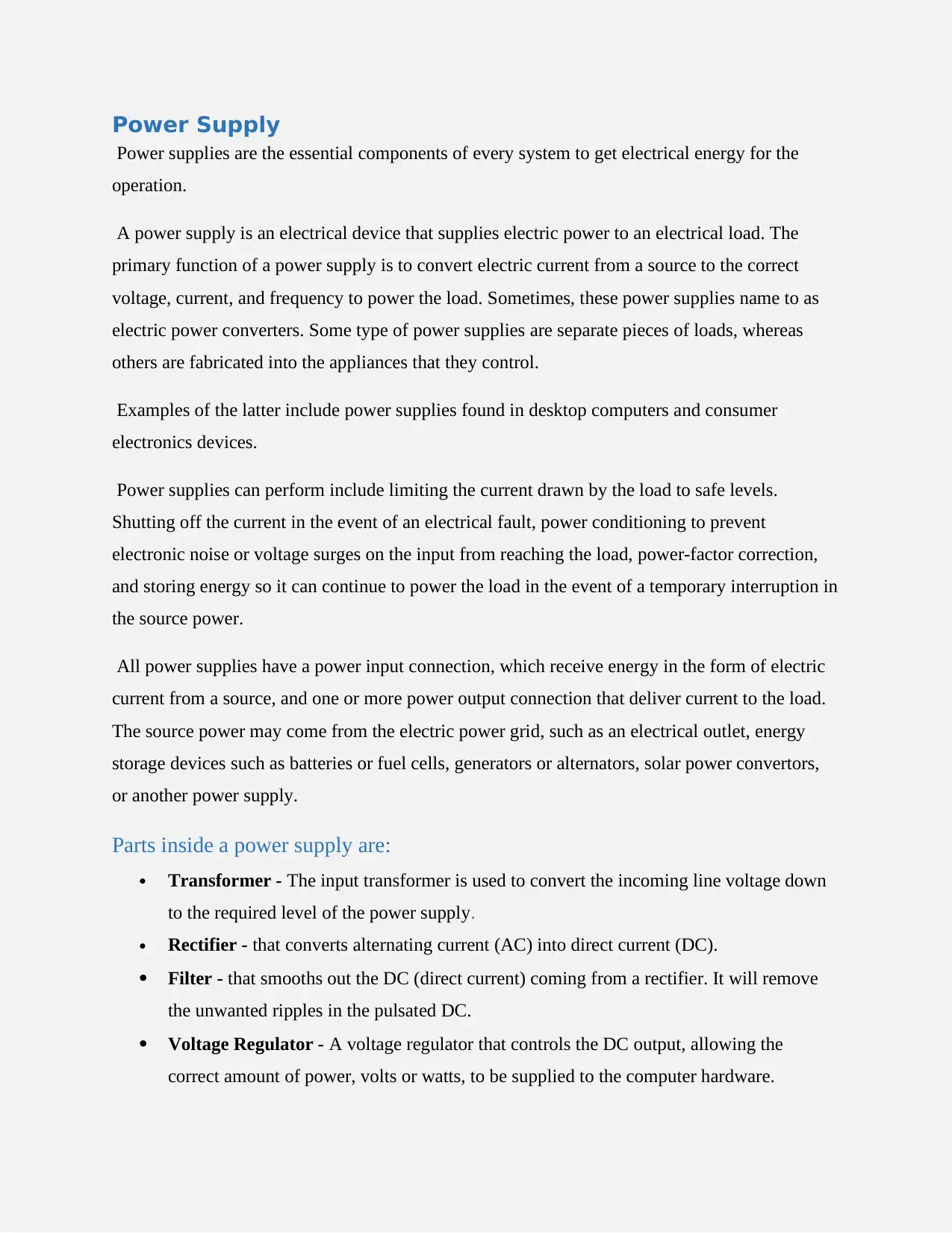
Power Supply
Power supplies are the essential components of every system to get electrical energy for the
operation.
A power supply is an electrical device that supplies electric power to an electrical load. The
primary function of a power supply is to convert electric current from a source to the correct
voltage, current, and frequency to power the load. Sometimes, these power supplies name to as
electric power converters. Some type of power supplies are separate pieces of loads, whereas
others are fabricated into the appliances that they control.
Examples of the latter include power supplies found in desktop computers and consumer
electronics devices.
Power supplies can perform include limiting the current drawn by the load to safe levels.
Shutting off the current in the event of an electrical fault, power conditioning to prevent
electronic noise or voltage surges on the input from reaching the load, power-factor correction,
and storing energy so it can continue to power the load in the event of a temporary interruption in
the source power.
All power supplies have a power input connection, which receive energy in the form of electric
current from a source, and one or more power output connection that deliver current to the load.
The source power may come from the electric power grid, such as an electrical outlet, energy
storage devices such as batteries or fuel cells, generators or alternators, solar power convertors,
or another power supply.
Parts inside a power supply are:
Transformer - The input transformer is used to convert the incoming line voltage down
to the required level of the power supply.
Rectifier - that converts alternating current (AC) into direct current (DC).
Filter - that smooths out the DC (direct current) coming from a rectifier. It will remove
the unwanted ripples in the pulsated DC.
Voltage Regulator - A voltage regulator that controls the DC output, allowing the
correct amount of power, volts or watts, to be supplied to the computer hardware.
Power supplies are the essential components of every system to get electrical energy for the
operation.
A power supply is an electrical device that supplies electric power to an electrical load. The
primary function of a power supply is to convert electric current from a source to the correct
voltage, current, and frequency to power the load. Sometimes, these power supplies name to as
electric power converters. Some type of power supplies are separate pieces of loads, whereas
others are fabricated into the appliances that they control.
Examples of the latter include power supplies found in desktop computers and consumer
electronics devices.
Power supplies can perform include limiting the current drawn by the load to safe levels.
Shutting off the current in the event of an electrical fault, power conditioning to prevent
electronic noise or voltage surges on the input from reaching the load, power-factor correction,
and storing energy so it can continue to power the load in the event of a temporary interruption in
the source power.
All power supplies have a power input connection, which receive energy in the form of electric
current from a source, and one or more power output connection that deliver current to the load.
The source power may come from the electric power grid, such as an electrical outlet, energy
storage devices such as batteries or fuel cells, generators or alternators, solar power convertors,
or another power supply.
Parts inside a power supply are:
Transformer - The input transformer is used to convert the incoming line voltage down
to the required level of the power supply.
Rectifier - that converts alternating current (AC) into direct current (DC).
Filter - that smooths out the DC (direct current) coming from a rectifier. It will remove
the unwanted ripples in the pulsated DC.
Voltage Regulator - A voltage regulator that controls the DC output, allowing the
correct amount of power, volts or watts, to be supplied to the computer hardware.
⊘ This is a preview!⊘
Do you want full access?
Subscribe today to unlock all pages.

Trusted by 1+ million students worldwide

Power Supply Block Diagram
The power supply block diagram, and the systematic conversion of 230V AC to 12V DC is
discussed below.
A step-down transformer converts the 230V AC into12v.
The bridge rectifier is used to change AC to DC
A capacitor is used to filter the AC ripples and gives to the voltage regulator.
Finally, voltage regulator regulates the voltage to 5V and finally, a blocking diode is used
for taking the pulsating waveform.
Power Supply Block Diagram
Types of power supply
SMPS- Switched Mode Power Supply
An SMPS power supply is one type of power supply that includes a switching regulator for
converting electrical-power powerfully. This power supply transmits the power from a DC
source or AC source to DC loads, such as a PC (personal computer), while changing the
characteristics of current and voltage.
SMPS – Switched Mode Power Supply
The power supply block diagram, and the systematic conversion of 230V AC to 12V DC is
discussed below.
A step-down transformer converts the 230V AC into12v.
The bridge rectifier is used to change AC to DC
A capacitor is used to filter the AC ripples and gives to the voltage regulator.
Finally, voltage regulator regulates the voltage to 5V and finally, a blocking diode is used
for taking the pulsating waveform.
Power Supply Block Diagram
Types of power supply
SMPS- Switched Mode Power Supply
An SMPS power supply is one type of power supply that includes a switching regulator for
converting electrical-power powerfully. This power supply transmits the power from a DC
source or AC source to DC loads, such as a PC (personal computer), while changing the
characteristics of current and voltage.
SMPS – Switched Mode Power Supply
Paraphrase This Document
Need a fresh take? Get an instant paraphrase of this document with our AI Paraphraser
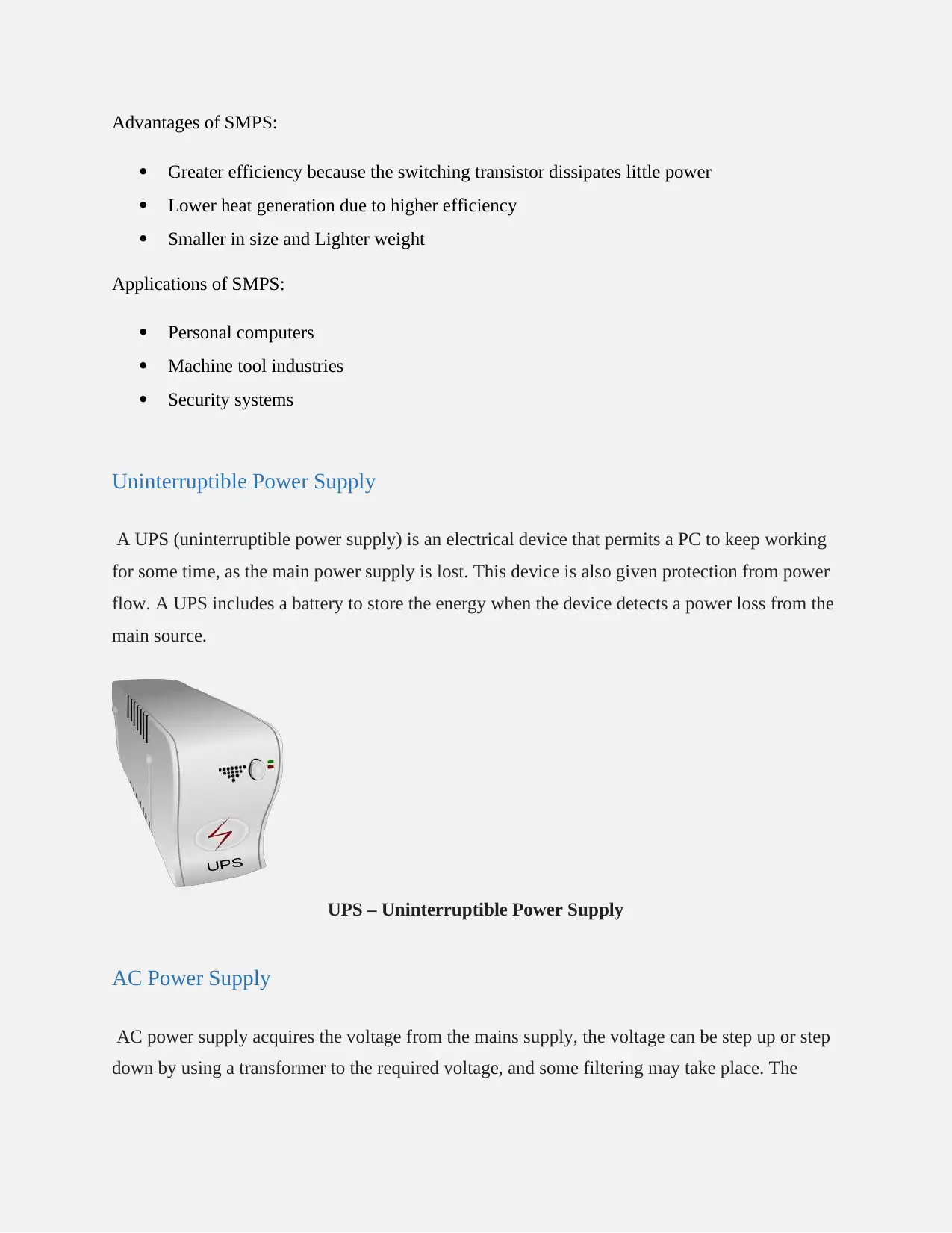
Advantages of SMPS:
Greater efficiency because the switching transistor dissipates little power
Lower heat generation due to higher efficiency
Smaller in size and Lighter weight
Applications of SMPS:
Personal computers
Machine tool industries
Security systems
Uninterruptible Power Supply
A UPS (uninterruptible power supply) is an electrical device that permits a PC to keep working
for some time, as the main power supply is lost. This device is also given protection from power
flow. A UPS includes a battery to store the energy when the device detects a power loss from the
main source.
UPS – Uninterruptible Power Supply
AC Power Supply
AC power supply acquires the voltage from the mains supply, the voltage can be step up or step
down by using a transformer to the required voltage, and some filtering may take place. The
Greater efficiency because the switching transistor dissipates little power
Lower heat generation due to higher efficiency
Smaller in size and Lighter weight
Applications of SMPS:
Personal computers
Machine tool industries
Security systems
Uninterruptible Power Supply
A UPS (uninterruptible power supply) is an electrical device that permits a PC to keep working
for some time, as the main power supply is lost. This device is also given protection from power
flow. A UPS includes a battery to store the energy when the device detects a power loss from the
main source.
UPS – Uninterruptible Power Supply
AC Power Supply
AC power supply acquires the voltage from the mains supply, the voltage can be step up or step
down by using a transformer to the required voltage, and some filtering may take place. The
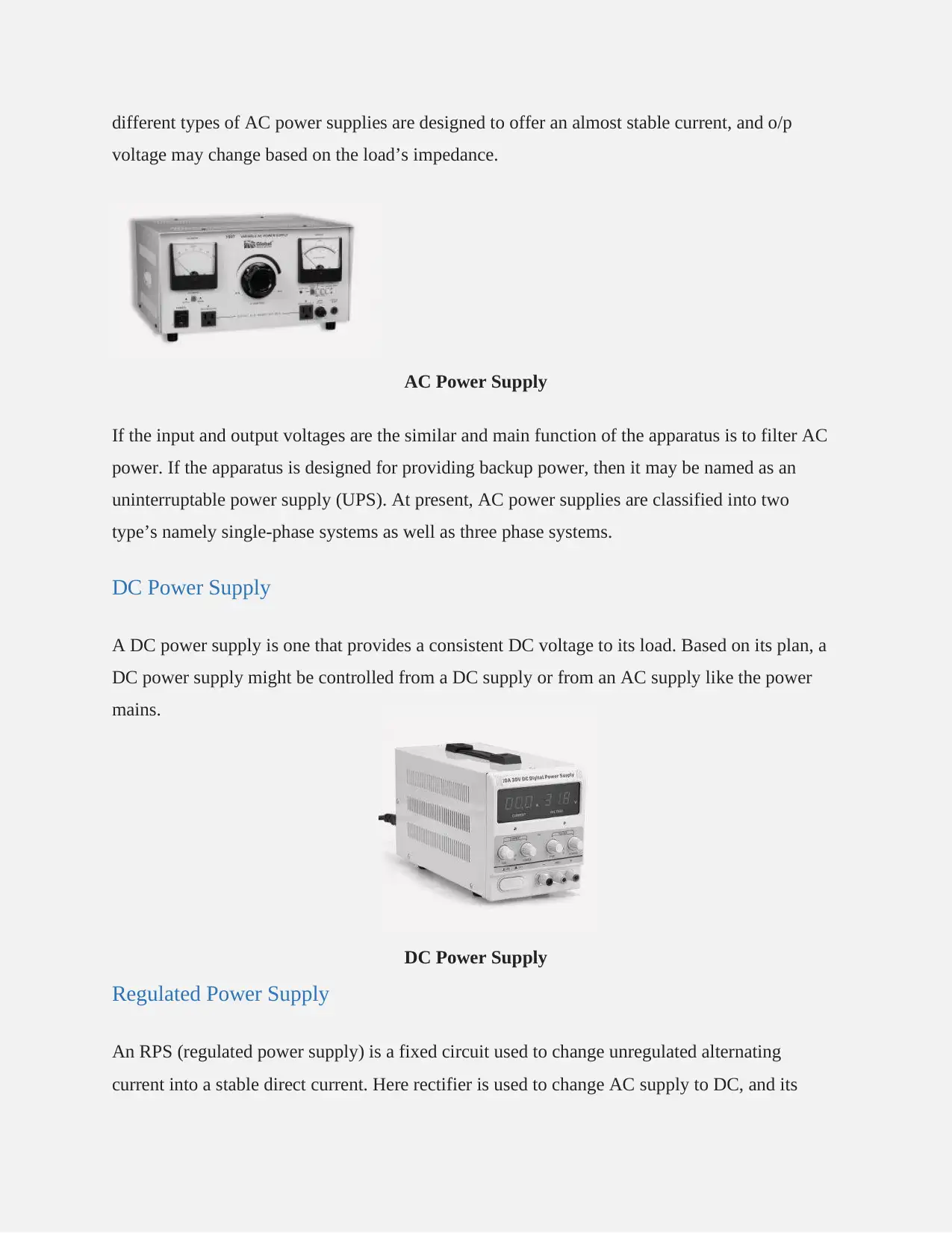
different types of AC power supplies are designed to offer an almost stable current, and o/p
voltage may change based on the load’s impedance.
AC Power Supply
If the input and output voltages are the similar and main function of the apparatus is to filter AC
power. If the apparatus is designed for providing backup power, then it may be named as an
uninterruptable power supply (UPS). At present, AC power supplies are classified into two
type’s namely single-phase systems as well as three phase systems.
DC Power Supply
A DC power supply is one that provides a consistent DC voltage to its load. Based on its plan, a
DC power supply might be controlled from a DC supply or from an AC supply like the power
mains.
DC Power Supply
Regulated Power Supply
An RPS (regulated power supply) is a fixed circuit used to change unregulated alternating
current into a stable direct current. Here rectifier is used to change AC supply to DC, and its
voltage may change based on the load’s impedance.
AC Power Supply
If the input and output voltages are the similar and main function of the apparatus is to filter AC
power. If the apparatus is designed for providing backup power, then it may be named as an
uninterruptable power supply (UPS). At present, AC power supplies are classified into two
type’s namely single-phase systems as well as three phase systems.
DC Power Supply
A DC power supply is one that provides a consistent DC voltage to its load. Based on its plan, a
DC power supply might be controlled from a DC supply or from an AC supply like the power
mains.
DC Power Supply
Regulated Power Supply
An RPS (regulated power supply) is a fixed circuit used to change unregulated alternating
current into a stable direct current. Here rectifier is used to change AC supply to DC, and its
⊘ This is a preview!⊘
Do you want full access?
Subscribe today to unlock all pages.

Trusted by 1+ million students worldwide
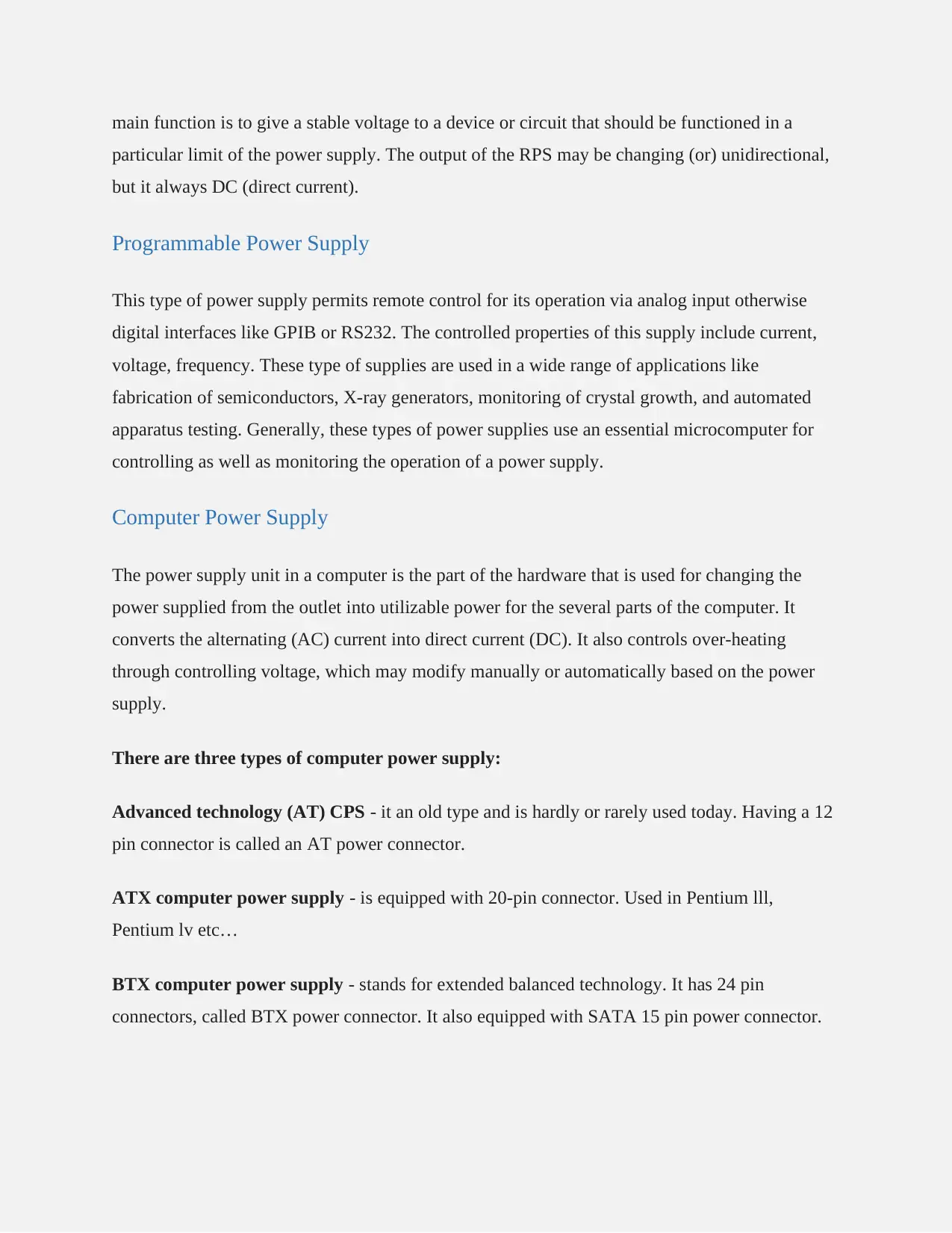
main function is to give a stable voltage to a device or circuit that should be functioned in a
particular limit of the power supply. The output of the RPS may be changing (or) unidirectional,
but it always DC (direct current).
Programmable Power Supply
This type of power supply permits remote control for its operation via analog input otherwise
digital interfaces like GPIB or RS232. The controlled properties of this supply include current,
voltage, frequency. These type of supplies are used in a wide range of applications like
fabrication of semiconductors, X-ray generators, monitoring of crystal growth, and automated
apparatus testing. Generally, these types of power supplies use an essential microcomputer for
controlling as well as monitoring the operation of a power supply.
Computer Power Supply
The power supply unit in a computer is the part of the hardware that is used for changing the
power supplied from the outlet into utilizable power for the several parts of the computer. It
converts the alternating (AC) current into direct current (DC). It also controls over-heating
through controlling voltage, which may modify manually or automatically based on the power
supply.
There are three types of computer power supply:
Advanced technology (AT) CPS - it an old type and is hardly or rarely used today. Having a 12
pin connector is called an AT power connector.
ATX computer power supply - is equipped with 20-pin connector. Used in Pentium lll,
Pentium lv etc…
BTX computer power supply - stands for extended balanced technology. It has 24 pin
connectors, called BTX power connector. It also equipped with SATA 15 pin power connector.
particular limit of the power supply. The output of the RPS may be changing (or) unidirectional,
but it always DC (direct current).
Programmable Power Supply
This type of power supply permits remote control for its operation via analog input otherwise
digital interfaces like GPIB or RS232. The controlled properties of this supply include current,
voltage, frequency. These type of supplies are used in a wide range of applications like
fabrication of semiconductors, X-ray generators, monitoring of crystal growth, and automated
apparatus testing. Generally, these types of power supplies use an essential microcomputer for
controlling as well as monitoring the operation of a power supply.
Computer Power Supply
The power supply unit in a computer is the part of the hardware that is used for changing the
power supplied from the outlet into utilizable power for the several parts of the computer. It
converts the alternating (AC) current into direct current (DC). It also controls over-heating
through controlling voltage, which may modify manually or automatically based on the power
supply.
There are three types of computer power supply:
Advanced technology (AT) CPS - it an old type and is hardly or rarely used today. Having a 12
pin connector is called an AT power connector.
ATX computer power supply - is equipped with 20-pin connector. Used in Pentium lll,
Pentium lv etc…
BTX computer power supply - stands for extended balanced technology. It has 24 pin
connectors, called BTX power connector. It also equipped with SATA 15 pin power connector.
Paraphrase This Document
Need a fresh take? Get an instant paraphrase of this document with our AI Paraphraser
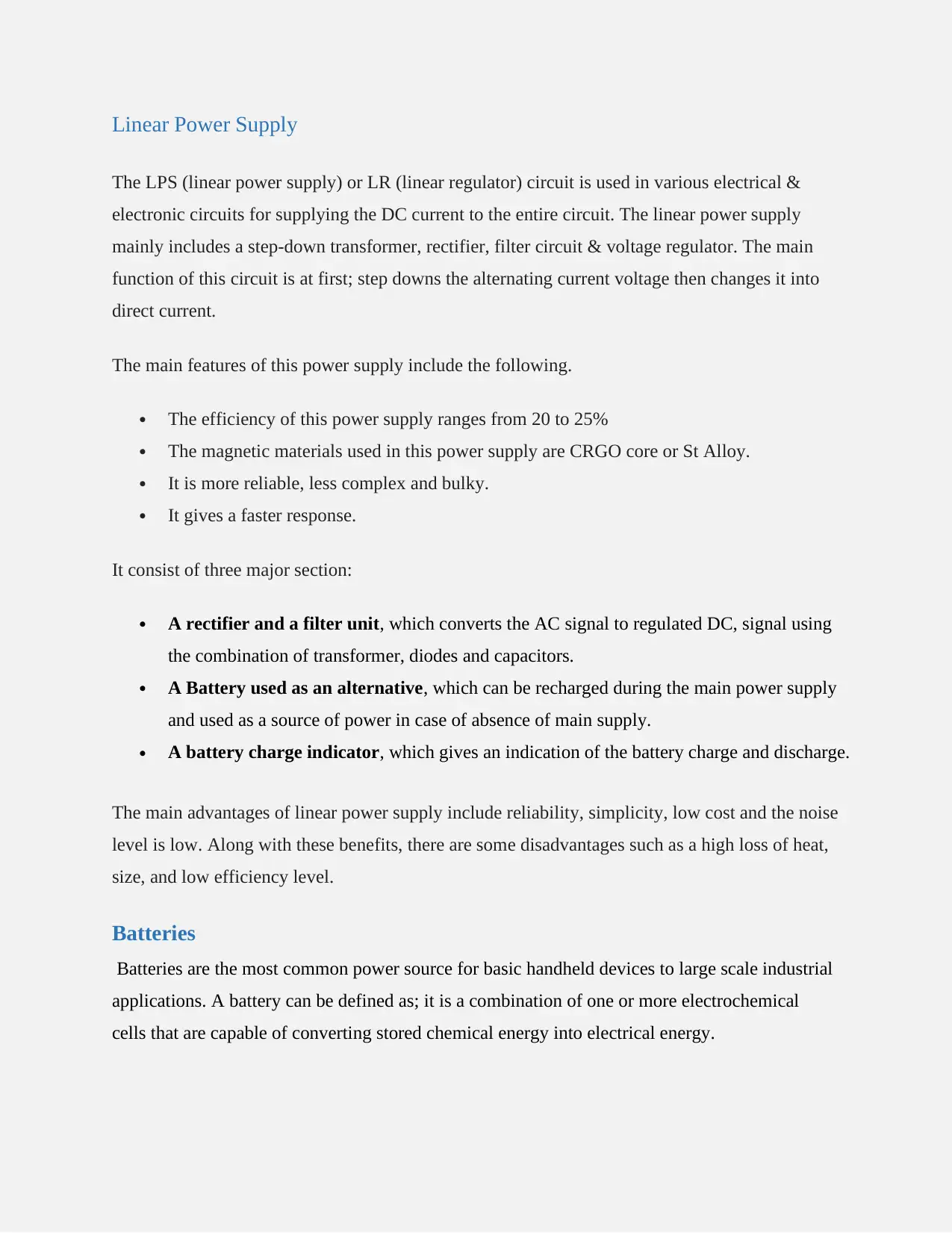
Linear Power Supply
The LPS (linear power supply) or LR (linear regulator) circuit is used in various electrical &
electronic circuits for supplying the DC current to the entire circuit. The linear power supply
mainly includes a step-down transformer, rectifier, filter circuit & voltage regulator. The main
function of this circuit is at first; step downs the alternating current voltage then changes it into
direct current.
The main features of this power supply include the following.
The efficiency of this power supply ranges from 20 to 25%
The magnetic materials used in this power supply are CRGO core or St Alloy.
It is more reliable, less complex and bulky.
It gives a faster response.
It consist of three major section:
A rectifier and a filter unit, which converts the AC signal to regulated DC, signal using
the combination of transformer, diodes and capacitors.
A Battery used as an alternative, which can be recharged during the main power supply
and used as a source of power in case of absence of main supply.
A battery charge indicator, which gives an indication of the battery charge and discharge.
The main advantages of linear power supply include reliability, simplicity, low cost and the noise
level is low. Along with these benefits, there are some disadvantages such as a high loss of heat,
size, and low efficiency level.
Batteries
Batteries are the most common power source for basic handheld devices to large scale industrial
applications. A battery can be defined as; it is a combination of one or more electrochemical
cells that are capable of converting stored chemical energy into electrical energy.
The LPS (linear power supply) or LR (linear regulator) circuit is used in various electrical &
electronic circuits for supplying the DC current to the entire circuit. The linear power supply
mainly includes a step-down transformer, rectifier, filter circuit & voltage regulator. The main
function of this circuit is at first; step downs the alternating current voltage then changes it into
direct current.
The main features of this power supply include the following.
The efficiency of this power supply ranges from 20 to 25%
The magnetic materials used in this power supply are CRGO core or St Alloy.
It is more reliable, less complex and bulky.
It gives a faster response.
It consist of three major section:
A rectifier and a filter unit, which converts the AC signal to regulated DC, signal using
the combination of transformer, diodes and capacitors.
A Battery used as an alternative, which can be recharged during the main power supply
and used as a source of power in case of absence of main supply.
A battery charge indicator, which gives an indication of the battery charge and discharge.
The main advantages of linear power supply include reliability, simplicity, low cost and the noise
level is low. Along with these benefits, there are some disadvantages such as a high loss of heat,
size, and low efficiency level.
Batteries
Batteries are the most common power source for basic handheld devices to large scale industrial
applications. A battery can be defined as; it is a combination of one or more electrochemical
cells that are capable of converting stored chemical energy into electrical energy.
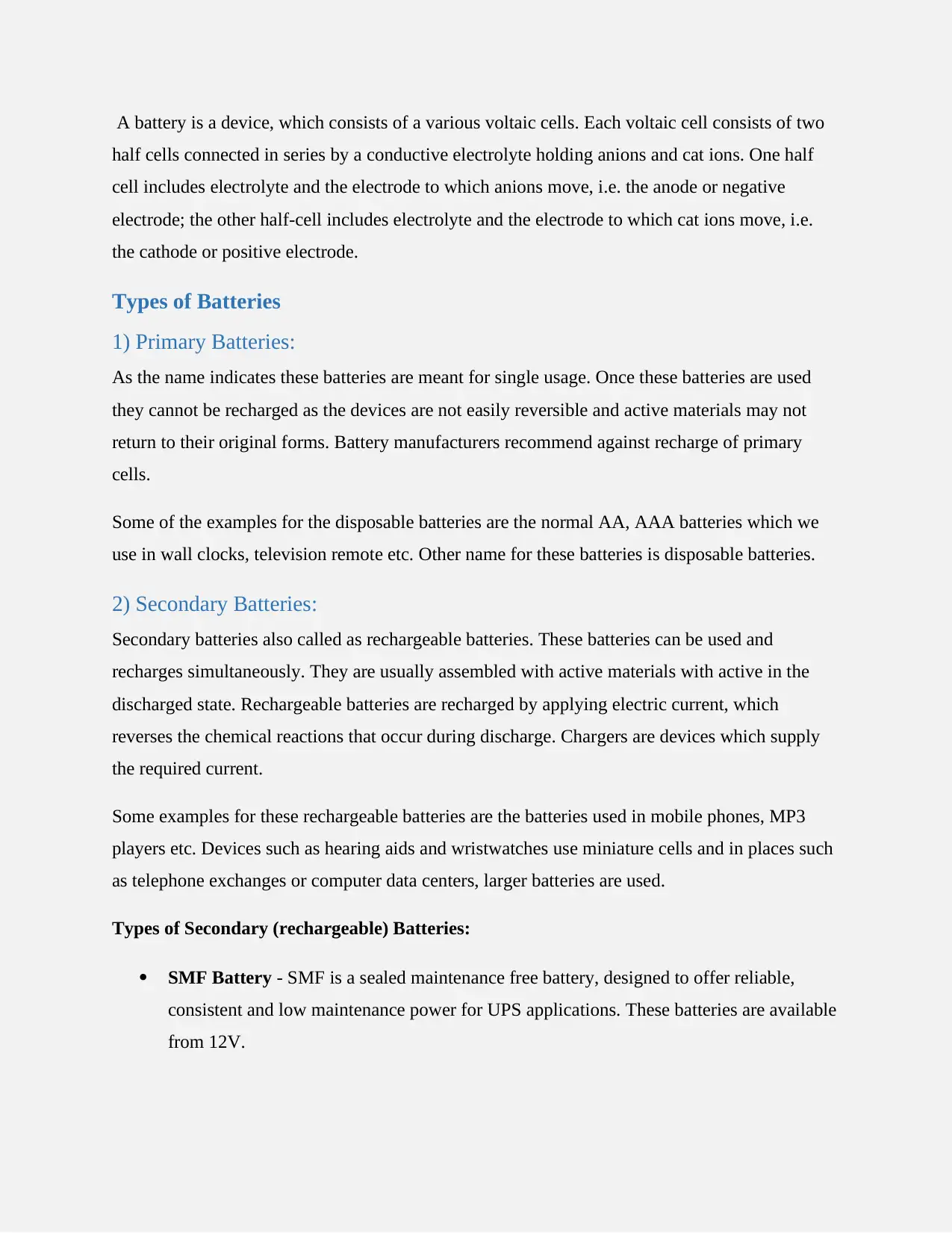
A battery is a device, which consists of a various voltaic cells. Each voltaic cell consists of two
half cells connected in series by a conductive electrolyte holding anions and cat ions. One half
cell includes electrolyte and the electrode to which anions move, i.e. the anode or negative
electrode; the other half-cell includes electrolyte and the electrode to which cat ions move, i.e.
the cathode or positive electrode.
Types of Batteries
1) Primary Batteries:
As the name indicates these batteries are meant for single usage. Once these batteries are used
they cannot be recharged as the devices are not easily reversible and active materials may not
return to their original forms. Battery manufacturers recommend against recharge of primary
cells.
Some of the examples for the disposable batteries are the normal AA, AAA batteries which we
use in wall clocks, television remote etc. Other name for these batteries is disposable batteries.
2) Secondary Batteries:
Secondary batteries also called as rechargeable batteries. These batteries can be used and
recharges simultaneously. They are usually assembled with active materials with active in the
discharged state. Rechargeable batteries are recharged by applying electric current, which
reverses the chemical reactions that occur during discharge. Chargers are devices which supply
the required current.
Some examples for these rechargeable batteries are the batteries used in mobile phones, MP3
players etc. Devices such as hearing aids and wristwatches use miniature cells and in places such
as telephone exchanges or computer data centers, larger batteries are used.
Types of Secondary (rechargeable) Batteries:
SMF Battery - SMF is a sealed maintenance free battery, designed to offer reliable,
consistent and low maintenance power for UPS applications. These batteries are available
from 12V.
half cells connected in series by a conductive electrolyte holding anions and cat ions. One half
cell includes electrolyte and the electrode to which anions move, i.e. the anode or negative
electrode; the other half-cell includes electrolyte and the electrode to which cat ions move, i.e.
the cathode or positive electrode.
Types of Batteries
1) Primary Batteries:
As the name indicates these batteries are meant for single usage. Once these batteries are used
they cannot be recharged as the devices are not easily reversible and active materials may not
return to their original forms. Battery manufacturers recommend against recharge of primary
cells.
Some of the examples for the disposable batteries are the normal AA, AAA batteries which we
use in wall clocks, television remote etc. Other name for these batteries is disposable batteries.
2) Secondary Batteries:
Secondary batteries also called as rechargeable batteries. These batteries can be used and
recharges simultaneously. They are usually assembled with active materials with active in the
discharged state. Rechargeable batteries are recharged by applying electric current, which
reverses the chemical reactions that occur during discharge. Chargers are devices which supply
the required current.
Some examples for these rechargeable batteries are the batteries used in mobile phones, MP3
players etc. Devices such as hearing aids and wristwatches use miniature cells and in places such
as telephone exchanges or computer data centers, larger batteries are used.
Types of Secondary (rechargeable) Batteries:
SMF Battery - SMF is a sealed maintenance free battery, designed to offer reliable,
consistent and low maintenance power for UPS applications. These batteries are available
from 12V.
⊘ This is a preview!⊘
Do you want full access?
Subscribe today to unlock all pages.

Trusted by 1+ million students worldwide
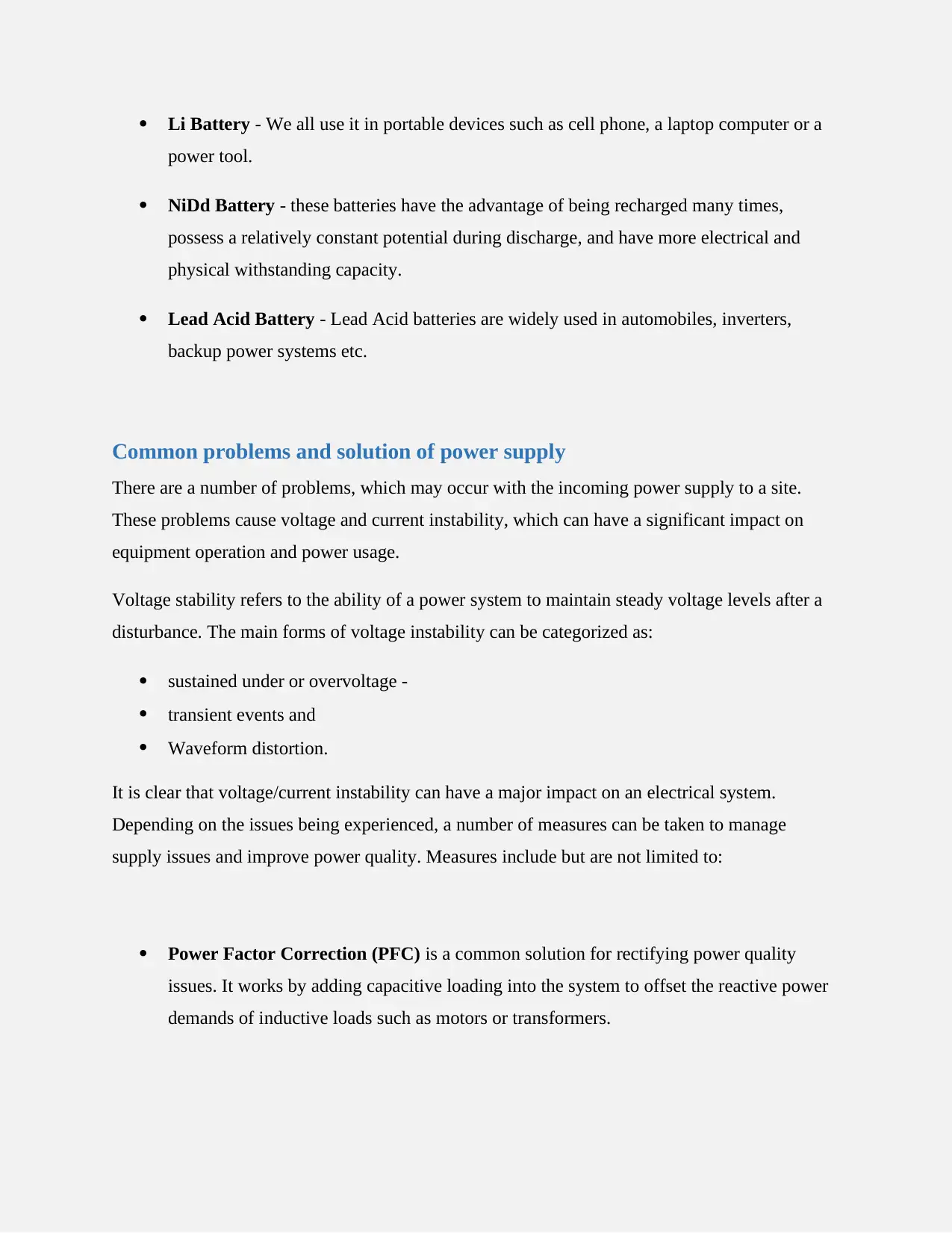
Li Battery - We all use it in portable devices such as cell phone, a laptop computer or a
power tool.
NiDd Battery - these batteries have the advantage of being recharged many times,
possess a relatively constant potential during discharge, and have more electrical and
physical withstanding capacity.
Lead Acid Battery - Lead Acid batteries are widely used in automobiles, inverters,
backup power systems etc.
Common problems and solution of power supply
There are a number of problems, which may occur with the incoming power supply to a site.
These problems cause voltage and current instability, which can have a significant impact on
equipment operation and power usage.
Voltage stability refers to the ability of a power system to maintain steady voltage levels after a
disturbance. The main forms of voltage instability can be categorized as:
sustained under or overvoltage -
transient events and
Waveform distortion.
It is clear that voltage/current instability can have a major impact on an electrical system.
Depending on the issues being experienced, a number of measures can be taken to manage
supply issues and improve power quality. Measures include but are not limited to:
Power Factor Correction (PFC) is a common solution for rectifying power quality
issues. It works by adding capacitive loading into the system to offset the reactive power
demands of inductive loads such as motors or transformers.
power tool.
NiDd Battery - these batteries have the advantage of being recharged many times,
possess a relatively constant potential during discharge, and have more electrical and
physical withstanding capacity.
Lead Acid Battery - Lead Acid batteries are widely used in automobiles, inverters,
backup power systems etc.
Common problems and solution of power supply
There are a number of problems, which may occur with the incoming power supply to a site.
These problems cause voltage and current instability, which can have a significant impact on
equipment operation and power usage.
Voltage stability refers to the ability of a power system to maintain steady voltage levels after a
disturbance. The main forms of voltage instability can be categorized as:
sustained under or overvoltage -
transient events and
Waveform distortion.
It is clear that voltage/current instability can have a major impact on an electrical system.
Depending on the issues being experienced, a number of measures can be taken to manage
supply issues and improve power quality. Measures include but are not limited to:
Power Factor Correction (PFC) is a common solution for rectifying power quality
issues. It works by adding capacitive loading into the system to offset the reactive power
demands of inductive loads such as motors or transformers.
Paraphrase This Document
Need a fresh take? Get an instant paraphrase of this document with our AI Paraphraser
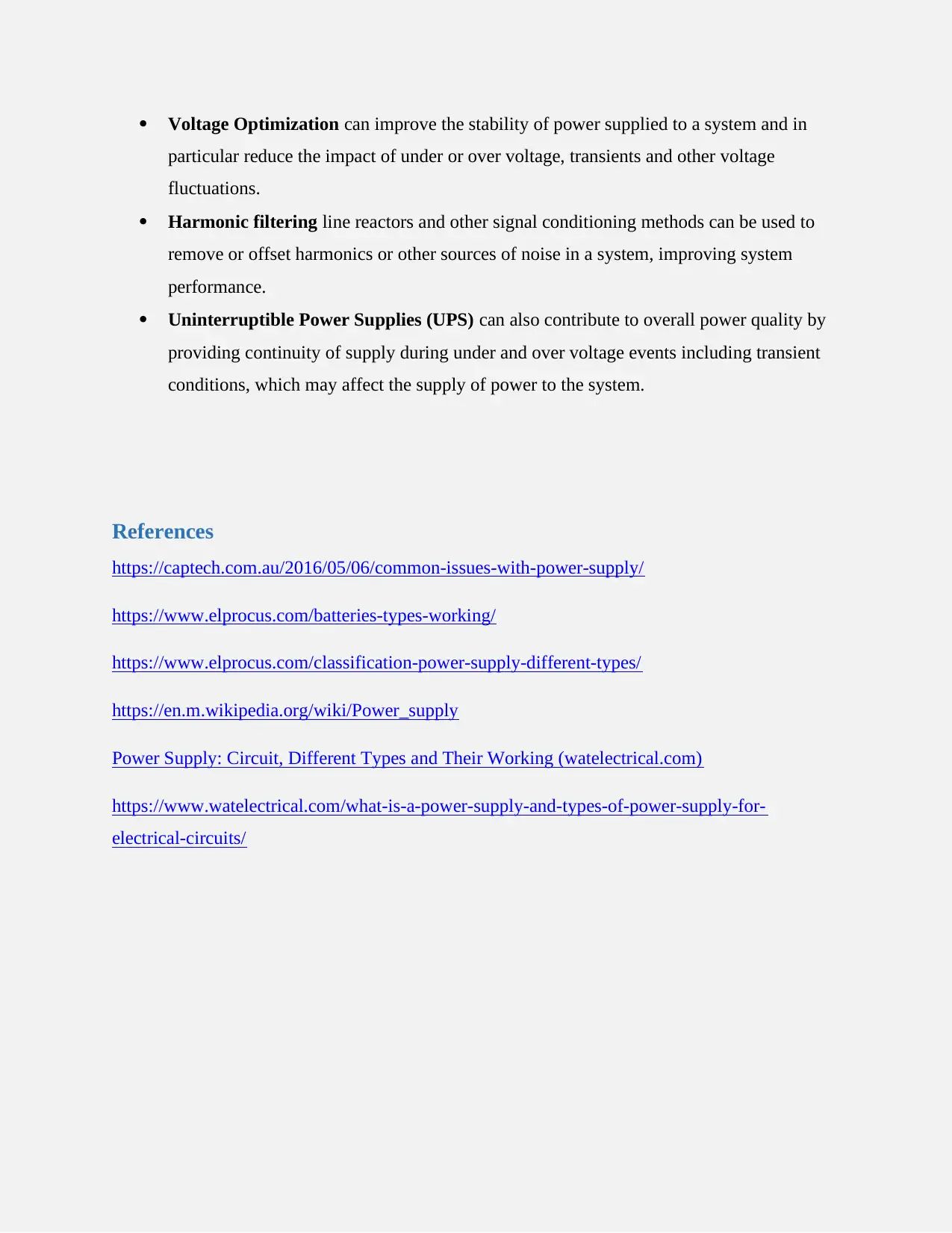
Voltage Optimization can improve the stability of power supplied to a system and in
particular reduce the impact of under or over voltage, transients and other voltage
fluctuations.
Harmonic filtering line reactors and other signal conditioning methods can be used to
remove or offset harmonics or other sources of noise in a system, improving system
performance.
Uninterruptible Power Supplies (UPS) can also contribute to overall power quality by
providing continuity of supply during under and over voltage events including transient
conditions, which may affect the supply of power to the system.
References
https://captech.com.au/2016/05/06/common-issues-with-power-supply/
https://www.elprocus.com/batteries-types-working/
https://www.elprocus.com/classification-power-supply-different-types/
https://en.m.wikipedia.org/wiki/Power_supply
Power Supply: Circuit, Different Types and Their Working (watelectrical.com)
https://www.watelectrical.com/what-is-a-power-supply-and-types-of-power-supply-for-
electrical-circuits/
particular reduce the impact of under or over voltage, transients and other voltage
fluctuations.
Harmonic filtering line reactors and other signal conditioning methods can be used to
remove or offset harmonics or other sources of noise in a system, improving system
performance.
Uninterruptible Power Supplies (UPS) can also contribute to overall power quality by
providing continuity of supply during under and over voltage events including transient
conditions, which may affect the supply of power to the system.
References
https://captech.com.au/2016/05/06/common-issues-with-power-supply/
https://www.elprocus.com/batteries-types-working/
https://www.elprocus.com/classification-power-supply-different-types/
https://en.m.wikipedia.org/wiki/Power_supply
Power Supply: Circuit, Different Types and Their Working (watelectrical.com)
https://www.watelectrical.com/what-is-a-power-supply-and-types-of-power-supply-for-
electrical-circuits/

⊘ This is a preview!⊘
Do you want full access?
Subscribe today to unlock all pages.

Trusted by 1+ million students worldwide
1 out of 12
Related Documents
Your All-in-One AI-Powered Toolkit for Academic Success.
+13062052269
info@desklib.com
Available 24*7 on WhatsApp / Email
![[object Object]](/_next/static/media/star-bottom.7253800d.svg)
Unlock your academic potential
Copyright © 2020–2026 A2Z Services. All Rights Reserved. Developed and managed by ZUCOL.





